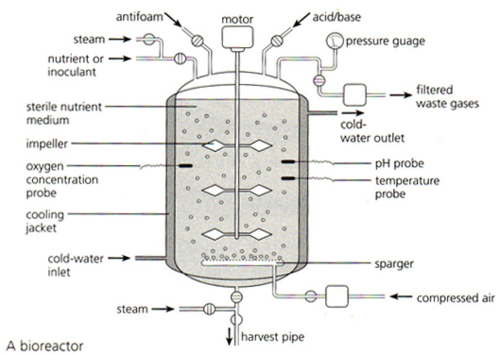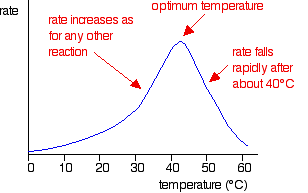5.9 explain the methods which are used to farm large numbers of fish to provide a source of protein, including maintenance of water quality, control of intra-specific and inter-specific predation, control of disease, removal of waste products, quality and frequency of feeding and the use of selective breeding.
Why fish are attractive to farmers:
1. Low fat, High protein
2. Efficient at turning nutrients into fish mass
Advantages:
They can control quality of the water (clean)
They can control predators
They can reduce pests and disease
This contributes to an increase in yield of fish.
High density of fish could cause high transmition in disease
Some farmers use antibiotics because of this (bad for human health)
Pesticides are also a cause of concern
Andrew Biology
Monday, February 20, 2012
5.8 Fermenter
5.8 interpret and label a diagram of an industrial fermenter and explain the need to provide suitable conditions in the fermenter, including aseptic precautions, nutrients, optimum temperature and pH, oxygenation and agitation, for growth of microorganisms.
Fermenter: the reaction vessel where fermentation occurs. The aim is to have optimum growth conditions for fermentation to occur.

Fermenters are used to give the reaction optimum conditions
Fermenter: the reaction vessel where fermentation occurs. The aim is to have optimum growth conditions for fermentation to occur.

Fermenters are used to give the reaction optimum conditions
5.7 Yogurt
5.7 Understand the role of bacteria (Lactobacillus) in the production of yogurt.
1. Cow produces milk
2. Milk treated to remove pathogens (e.g. TB). This is called pasteurization.
3. The milk sugars are converted into lactic acid (By incubating the milk at 45-46C and to add the lactobacillus)
4. Acid will result in a lower PH and causes milk proteins.
5. Milk proteins will solidify (yogurt).
1. Cow produces milk
2. Milk treated to remove pathogens (e.g. TB). This is called pasteurization.
3. The milk sugars are converted into lactic acid (By incubating the milk at 45-46C and to add the lactobacillus)
4. Acid will result in a lower PH and causes milk proteins.
5. Milk proteins will solidify (yogurt).
5.5 Beer production
5.5 Understand the role of yeast in the production of beer
Beer is largely Ethanol. This is produced from glucose which is broken down to ethanol and carbon dioxide.
Yeast + Enzymes
glucose ------------------------> ethanol + Carbon dioxide
Ethanol is flavored by the addition of plants.
amylase maltase
Starch ---------------> Moltose --------------------> Glucose
Starch comes from things such as barley seeds, wheat seed, and even rice.
This happens through the process called malting

Beer is largely Ethanol. This is produced from glucose which is broken down to ethanol and carbon dioxide.
Yeast + Enzymes
glucose ------------------------> ethanol + Carbon dioxide
Ethanol is flavored by the addition of plants.
amylase maltase
Starch ---------------> Moltose --------------------> Glucose
Starch comes from things such as barley seeds, wheat seed, and even rice.
This happens through the process called malting

5.4 Pesticides and biological control
5.4 understand the reasons for pest control and the advantages and disadvantages of using pesticides and biological control with crop plants.
a) Pesticides
Monocultrue: Where there are large fields of crops all of the same type
Monoculture --------> Pests crop food sources
This reduces productivity of farming. Loss of food and money.
Pesticides are chemicals which re designed to kill pests.
Advantages:
Chemicals are easy to obtain
They are easy to apply
3. Very effective
Disadvantage:
1. Toxic (will kill other plants and animals and harmful to humans)
2. Bio-accumulation (the pesticide builds up through the food chain cause problems for other animals)
3. Mutation in the pest often leads to resistance, meaning the concentration has to be constantly added till it no longer works and needs to be replaced.
B) Biological control
a) Pesticides
Monocultrue: Where there are large fields of crops all of the same type
Monoculture --------> Pests crop food sources
This reduces productivity of farming. Loss of food and money.
Pesticides are chemicals which re designed to kill pests.
Advantages:
Chemicals are easy to obtain
They are easy to apply
3. Very effective
Disadvantage:
1. Toxic (will kill other plants and animals and harmful to humans)
2. Bio-accumulation (the pesticide builds up through the food chain cause problems for other animals)
3. Mutation in the pest often leads to resistance, meaning the concentration has to be constantly added till it no longer works and needs to be replaced.
B) Biological control
Biological control is a way of reducing the population of a pest without using pesticides.
Another alien species has to be brought in that is higher in the food chain, to reduce the numbers of the population of the plant or animal
Advantages
1. Not toxic
2. Smaller impact on life
Disadvantages
1. Doesn't always work
2. Hard to control
3. The alien species could become unwanted
5.3 Fertilizers
5.3 understand the use of fertilizers to increase crop yield.
Fertilizers are usually Nitrates, phosphates or a combination of both.
These compounds are applied to the soil, they go down in the soil and are taken up by the plants root structure, and then moved in the transpiration stream up to the leaf and used in the leaf for the construction of proteins (nitrates) and phosphates (DNA and membrane structure).
Fertilizers can be divided into two groups:
1.Organic: produced from animal waste on farms, then collected by the farmer (usually after decomposition and fermentation) and forms a compound known as slurry which is applied to the fields, giving the plant a supply of nitrate and phosphate to promote growth.

2. Artificial: Chemical which are synthetically produced e.g. potassium nitrate and amonium nitrate, bought by the farmer and applied to the field which will go into a solution which will release the nitrates and phosphates which promotes growth.

Possibly causes Eutrophication which is a problem which arises from fertilizers.
Fertilizers are usually Nitrates, phosphates or a combination of both.
These compounds are applied to the soil, they go down in the soil and are taken up by the plants root structure, and then moved in the transpiration stream up to the leaf and used in the leaf for the construction of proteins (nitrates) and phosphates (DNA and membrane structure).
Fertilizers can be divided into two groups:
1.Organic: produced from animal waste on farms, then collected by the farmer (usually after decomposition and fermentation) and forms a compound known as slurry which is applied to the fields, giving the plant a supply of nitrate and phosphate to promote growth.
2. Artificial: Chemical which are synthetically produced e.g. potassium nitrate and amonium nitrate, bought by the farmer and applied to the field which will go into a solution which will release the nitrates and phosphates which promotes growth.

Possibly causes Eutrophication which is a problem which arises from fertilizers.
5.2 Crop Yield
5.2 understand the effects on crop yield of increased carbon dioxide and increased temperatures in glasshouses.
light+enzymes
Remember: photosynthesis= Carbon dioxide + water ---------------> Glucose + oxygen
Increasing the concentration of Co2 -------> Substrate
Increasing Co2:

Increasing temperature:

Increasing temperature also avoids frost damage and provides constant temperatures.
light+enzymes
Remember: photosynthesis= Carbon dioxide + water ---------------> Glucose + oxygen
Increasing the concentration of Co2 -------> Substrate
Increasing Co2:

Increasing temperature:

Increasing temperature also avoids frost damage and provides constant temperatures.
Subscribe to:
Posts (Atom)